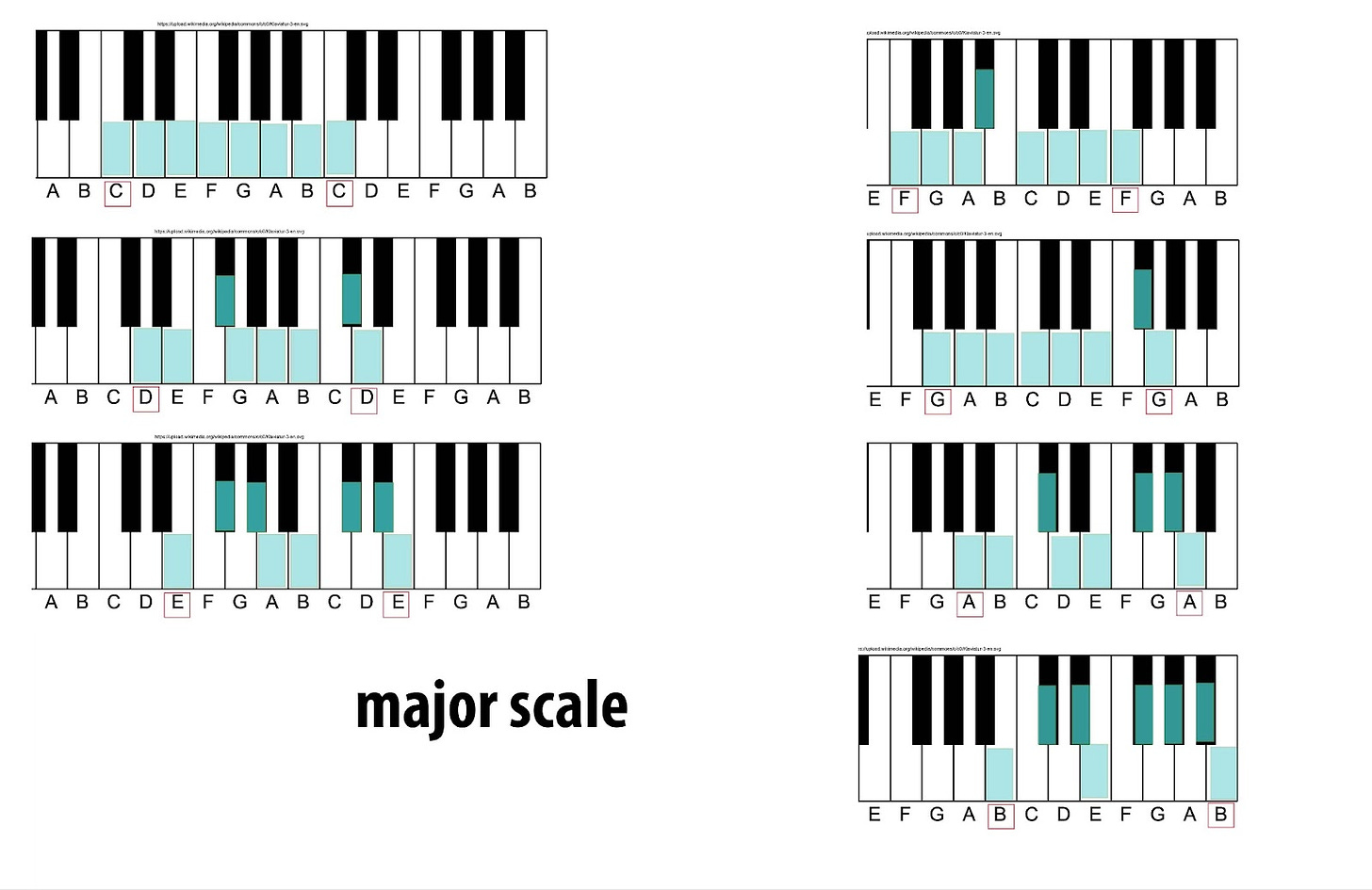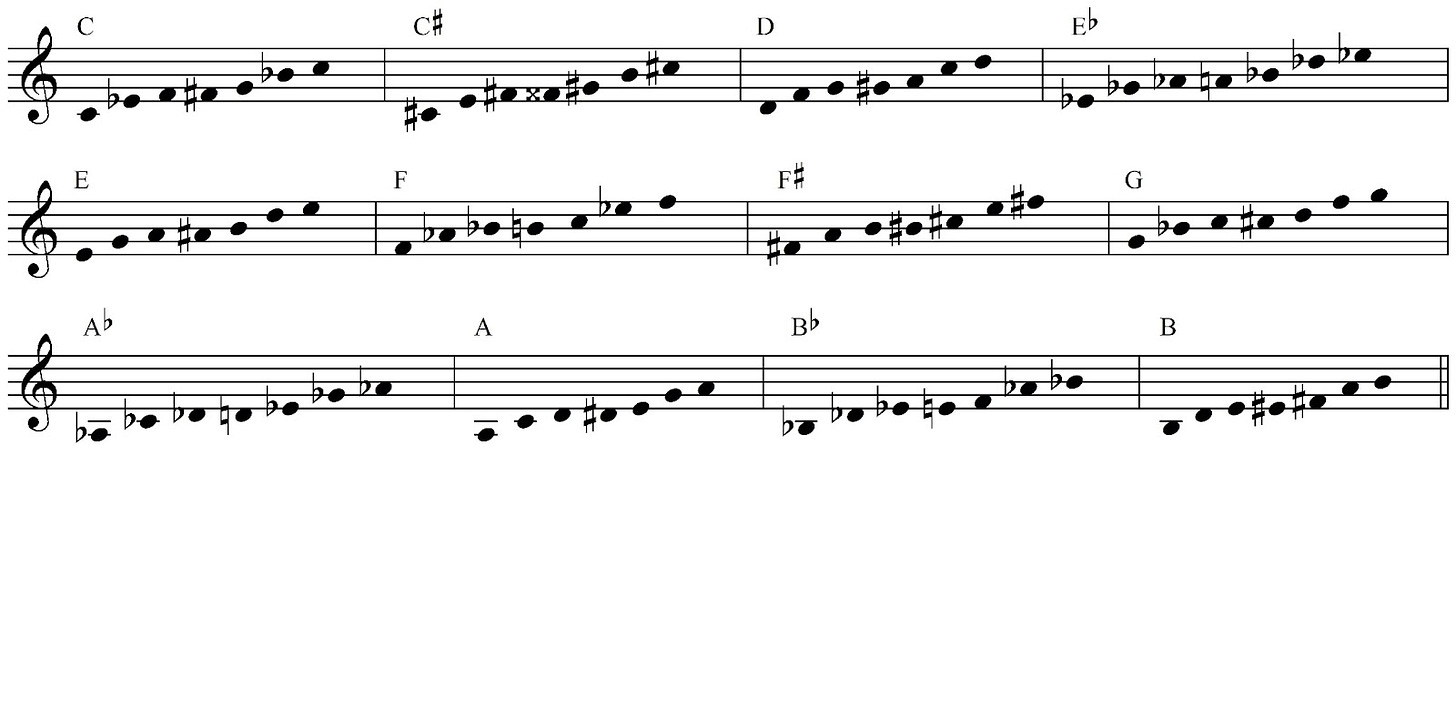Piano Scales for Beginners Guide: All Piano Scales Made Easy
All the scales that musicians need to develop their skills!
If you are looking to increase your knowledge of piano scales and want to learn the best piano scales for beginners then this guide will surely help!
This article contains a list of some of the most popular and useful scales and modes for many different styles of music, and they come in extremely handy when improvising and playing jazz music.
Related:
The Best Piano Exercises for Beginners
Digital Piano vs. Midi Keyboard Controller – Which is Better?
The Best Digital Pianos Under $1000: Expert Reviews
Piano Scales for Beginners Guide: All Piano Scales Made Easy
Contents [show]
Whether you are classically trained or not, you should look into practicing scales daily as part of your practice routine, to increase your piano skills with finger dexterity, hand independence, and two-handed playing.
The C Major Scale
A good starting point for new pianists is learning the C major scale.
Notice how the piano is organized in groups of 2 black notes and 3 black notes together.
You want to start the C major scale on middle C, though you can play it starting on any C note on the keyboard. You will find middle C to the left of two black notes, in the middle of the piano.
Starting on middle C you play all the white notes ascending up the piano until you get to the next C note an octave (7 notes) above.
This scale also builds a fundamental understanding of what a Major scale sounds like (happy and uplifting) and helps students to map out where notes are on the keyboard too.
Where Is Middle C?
Notice how the piano keyboard is made up of white and black notes.
The black notes are grouped in twos and threes and you can find middle C in the middle of the keyboard to the left of a group of two black notes.
Method
Starting on middle C, you play up the white notes and end on the C one octave above.
The most important thing you learn whilst playing this scale is proper finger technique. When you put both hands together you also learn finger and hand independence whilst playing simultaneously.
Step 1 – Going up
With the right-hand thumb positioned above the middle C, play the first three notes thumb, finger 2 (D), finger 3 (E), and then put your thumb under the third finger to play the (F) with your thumb again.
From there your thumb and 4 fingers can play the rest of the scale. You have now learned the ‘thumb tuck’ which will be a useful skill for many scales and exercises, as well as improvising.
Step 2 – Back down:
Coming back down is the same in the reverse where your third finger now crosses over your thumb on the (F) to hit the (E) and you will have your second and thumb to hit the last two notes.
Step 3 – Left Hand:
Playing the scale in your left hand is also the reverse of your right hand. Your little finger or pinky will start the scale and your middle finger will cross over on note 6 or the (A) on the keyboard.
Again, you will repeat in reverse on the way down, this time your thumb in your left hand will go underneath on the (A) to hit the (G) and you will use your remaining fingers to finish the scale. EASY!
Step 4 – Hands Together:
Now try putting both hands together and playing the scale simultaneously. This is where things get tricky, and it is important to play the scale slowly in both hands so that you can learn to control the movements.
Step 5 – All The White Keys.
Now that you have mastered the C major scale in both hands (how fast can you do it?) you should move on to learning new major scales in different keys.
You can start with the white note scales, so D Major, E Major, F Major, G Major, A Major, and B Major.
For you to be able to play all the major scales on the white keys, you will need to know which sharps and flats are in each key. See the image below for the exact notes in these major scales.
Step 6 – All The Black Keys
So you have mastered all the Major scales starting on the white keys? Guess what, you have to learn them all on the black keys too, and they are all completely different!
This is something that may take several days and several more to memorize the patterns completely.
Tip – Do not push yourself to try and learn all the major scales in all keys immediately as this is a big task.
Try to learn and master the white keys first, and then practice the major scales on the sharps and flats, starting with C sharp, also known as D flat.
You can also learn your major scales in a different way, which goes up in fifths. This is a preferred method for some, and worth looking at to see if it makes more sense for you.
What Is the Circle of Fifths?
The circle of fifths is a method of learning the major scales where you move up a fifth after every scale. You would play your major scales in order of C, G, D, A, E, B, F sharp, C sharp, and G sharp.
Notice how every time you move up a scale you are adding one extra ‘accidental’ or sharpened note. You are moving around the keyboard with the sharp keys.
You can also do this in reverse by going back in 4ths from any given point and you will have played all keys in order of the flat keys.
Each time you play a scale you are now adding one ‘accidental’ which will be a ‘flattened note’. The order would be C, F, B flat, E flat, A flat, and D flat.
A diagram of the circle of fifths/circle of fourths:
(Notice how the relative minor keys are also inside the diagram, as you can also use the circle of fifths to play your minor keys in the same way as the major keys)
Minor Scales
What Is a Minor Scale?
Minor scales have a very different sound compared to major scales. They have a sad and slightly exotic sound that jazz musicians use to improvise on songs in minor keys.
The minor scale comes in 3 forms and you should learn the differences between them.
Natural Minor Scale
The most common Minor scale is also known as the ‘Aeolian mode’, (see modes below). You can play all of your Natural minor scales in the circle of fifths and the circle of fourths as well.
The natural minor scale has the same notes as its relative major scale. The relative Minor scale of a Major scale is found by starting on the ‘6th degree’ or 6th note of any major scale.
When playing C major, the 6th note you play will be an ‘A’. Start your C major scale on the A instead of the C and finish on the A an octave above.
Use the same fingering for this scale as you did with the C major scale, implementing the ‘thumb tuck’ technique. You have now played your first Natural minor scale, ‘The A Natural Minor Scale’.
You can also the relative Major scale for any given Natural Minor scale by moving a ‘Minor third’ above your starting note. You should know a ‘Major Third’ is two whole notes above your starting note, so E is a Major Third above C.
Minor thirds?
A ‘Minor third’ is a flattened third, so one and a half tones or 3 semitones above your starting note. Eb is a minor third above C. C Major is therefore the relative major scale to A Minor and Eb Major is the relative major scale to C Minor.
This may take a while to get your head around, but once you do, you will have understood the relationships between Major scales and Minor scales. Remember, these are the same scales starting on different notes!
If you want to improvise with your new scales, you must also learn the relationships between chords and scales. You can use the Natural Minor scales on the Minor chords and Minor 7th chords, or for a unique flavor on Major chords.
If you are looking to increase your knowledge of piano scales or boost your skills on another instrument such as a guitar or saxophone, then you should aim to practice many different types of scales.
Piano Scales Book
Harmonic Minor Scale
This is the same scale as the Natural Minor but with a raised 7th. This means you ‘sharpen’ the 7th note in the scale, and so A Harmonic Minor would have a G sharp instead of a G natural. Notice how this changes the sound of the scale.
You should practice your Harmonic Minor scales in both hands the same as you did with your major scales and hopefully your Natural Minor scales. Also, try to understand the chords you can use the scale with.
With the raised 7th, you now have to think about what sound you are creating if you are improvising over a minor or minor 7th chord.
The Harmonic Minor is therefore well suited to the Minor-Major 7th chord, but you should also create some interesting dissonance or use the 7th as a ‘chromatic passing tone’ when improvising over regular minor 7th chords.
Making Chords
Notice how you can also make chords out of your scale starting on different notes. The Harmonic Minor has the same chords as the natural minor except for the major chord built on the 5th degree, again due to the sharpened 7th.
Building chords out of your scale tones will help you understand harmony, and you can use the triadic groupings in improvisation as well.
Melodic Minor Scale
Here we have a minor scale that is a bit different. With raised sixth and seventh scale degrees you have a completely different sound again, but you only play these notes when ascending.
A descending melodic minor scale is identical to a natural minor scale, and remembering this when coming back down the scale is the challenge.
Again, try playing your melodic minor scales in both hands, ascending and descending, and over several octaves.
The melodic minor scale gives you a third musical flavor to add to your improvisation, and you should have all 3 minor scales in mind when practicing and playing over minor progressions and chords.
Blues Scale
The blues scale is another useful scale, especially for improvisation. Its main use comes when improvising over blues or jazz progressions, and can be used on dominant chords (flattened 7th with a major triad), and minor 7th chords as well.
The blues scale is made up of only 6 notes instead of 7. That is one less to remember! Starting with C blues, the notes are C, Eb, F, Gb, G, Bb, and C again.
You have a flattened 3rd, a fourth, a flattened fifth (or sharpened fourth), a fifth, and a flattened 7th. Now that you know the pattern and the intervals you need, you should be able to work out the other blues scales
If not there is a handy image below giving you the exact notes for each key. Notice how there are specific patterns for the blues scales that you can memorize and have in muscle memory.
Practicing the Blues
You want to be able to play all these scales fast ideally so that you can do quick runs, trills, and perform ideas across the keyboard (or guitar).
This means you should play your scales to a metronome if possible (you can get free metronome apps) and gradually increase the speed.
You can practice your blues scales in both hands one at a time and together across 2 octaves, or across the entire piano if you prefer.
Try playing your major, minor, and blues scales in your right hand with the relevant chords in your left hand as well. This will get you used to ‘comping’ with chords in your left hand and improvising with your right hand.
Once you have learned the chords that go with the 12-bar blues and the blues scales, try to practice some improvising! The video above (I made) will help you master the 12-bar blues progression and learn some improvisation techniques.
How to Play the 12 Bar Blues: Expert Guide
Pentatonic Scale
The pentatonic scale is made up of only 5 notes! The major pentatonic is the first one we will look at.
It has notes 1, 2, 3, 5, and 6 of the major scale we learned at the start. C major pentatonic uses C, D, E, G, and A. You can learn these patterns in both hands to create unique improvisations.
The minor pentatonic scale is like a simplified version of the blues scale we just looked at.
It has the 1st, flat 3rd, 4th, 5th, and flat 7th, and is derived from the natural minor scale. C minor pentatonic is therefore comprised of C, Eb, F, G, Bb, and C.
Chromatic Scale
The chromatic scale uses all the notes on your instrument in succession. If you are on a piano that means starting on C you would play all the notes including the black and white notes.
Interestingly, you can play this scale using just your thumb, index, and third finger.
Practice this scale in both hands, ascending and descending, across the entire keyboard. Try starting it on different notes as well, though this should not alter the fingering that you need to play it.
The Modes of the Major Scale
Modes are another set of scales that you can learn and if you are looking into jazz theory and improvisation, they will help you to improvise freely over any given chord progression.
Learning your modes will also allow you to create more interesting musical ideas.
There are 7 modes based on the major scale.
Ionian
Dorian
Phrygian
Lydian
Mixolydian
Aeolian
Locrian
Ionian
The same scale as the standard major scale. You can therefore skip the first mode of the major scale as we have covered it already, but make sure to practice the Ionian in all keys and hands together!
Dorian
The Dorian scale is similar to the natural minor scale except it has a natural 6th instead of a flattened 6th. The C Dorian scale is C, D, Eb, F, G, A, Bb, and C.
Another way of finding your Dorian scale is to think about the fact that it is made of the major scale one tone below your starting note.
As the second note of the Bb major scale is a C, you can think about C Dorian as a Bb major starting on C instead of Bb.
Phrygian
The Phrygian mode is similar to the natural minor also, though it adds an accidental instead of removing one like the dorian scale.
Playing your C Phrygian scale would be the same as playing Ab major starting on C. You have a flattened 2nd added to your natural minor, which is a Db. The notes would be C, Db, Eb, F, G, Ab, Bb, and C.
Lydian
Your Lydian scale is quite straightforward as it is comprised of the same notes as the major scale but with an added sharp 4.
The C Lydian scale is C, D, E, F sharp, G, A, B, and C. As it is the 4th mode of the major scale, you can again think of it as G major starting on C.
Mixolydian
Your Mixolydian scale is the fifth mode and is just a major scale with one addition like the Lydian scale.
Here you have a flattened 7th which means the scale works well over dominant chords which also have the flat 7. You are also playing F major starting on C.
Aeolian
Aeolian is one of the more interesting sounding modes, and you should recognize it, as it is the same scale as the natural minor scale!
As we have already covered the natural minor we can move on to the final mode of the major scale.
Locrian
The Locrian is an odd-sounding scale that is the least used. It is based on the 7th note of the major scale (so a B natural in the C major scale) and is used on the 7th chord of the major scale which is a diminished chord.
Again you play all the notes of the major scale starting on the 7 note, so B Locrian would be all the white notes, or C major starting on and finishing on a B natural.
Modes of the Harmonic Minor Scale
In addition to the modes based on the major scale, there are also several modes based on the minor scale that are commonly used in jazz music.
These modes have a darker and more somber sound than the major modes, and they are often used in jazz ballads and slower tunes.
The Harmonic Minor (Aeolian Scale With #7)
The first mode of the minor scales is the standard Harmonic minor scale that we have mentioned already.
The Locrian ♯6
The Locrian sharp 6 scale is designed to be used over the diminished chord.
It consists of the same notes as the Locrian scale but with a sharpened 6th (which is a natural 6th in its major scale which was flattened in the regular Locrian scale) added in.
1, ♭2, ♭3, 4, ♭5, 6, ♭7, 8
The Ionian ♯5 (Augmented-Major)
The Ionian #5 scale is used over the #5 Major 7 chord. It consists of the regular notes from the Ionian or major scale, with an added sharpened 5th.
1, 2, 3, 4, ♯5, 6, 7, 8
Ukrainian Dorian Scale (Altered Dorian)
A slightly altered version of the Dorian scale from the major modes. Notice that there is a sharpened fourth included in this scale that is not present in the ordinary Dorian scale.
It can be used over minor chords as well as the standard Dorian and works on minor 7th chords with added 9ths, sharp 11ths, and 13ths.
1, 2, ♭3, ♯4, 5, 6, ♭7, 8
Phrygian Dominant Scale
The Phrygian dominant scale is a Phrygian scale with a major 3rd instead of a minor 3rd. Play this scale over dominant chords with flat 9s, 11s, and flat 13s.
1, ♭2, 3, 4, 5, ♭6, ♭7, 8
Lydian ♯2
The Lydian sharp 2 scale is exactly what it says on the tin. A Locrian with a sharpened 2nd is useful on Major sharp 4 chords, but also Major chords with a sharp 9 and sharp 11 (same as sharp 4).
1, ♯2, 3 ,♯4, 5, 6, 7, 8
Super-Locrian Scale Double Flat7 (Altered Diminished)
The Super Locrian scale with a double flat 7. Notice that a double flat 7 is the same as a major 6th note.
1, ♭2, ♭3, ♭4, ♭5, ♭6, double, flat7, 8
Related:
The Best Rock Pianists of All Time (Top 12)
Korg D1 Full Review: The Best Budget Stage Piano?
Conclusion
You now have as many scales as any musician needs when starting out with their instrument.
All of these scales will give you the fundamentals and foundations of music theory, especially when practiced in conjunction with the associated chords.
Try to practice all of your scales with both hands together and also in your right hand, with the relevant chords played in the left hand.










